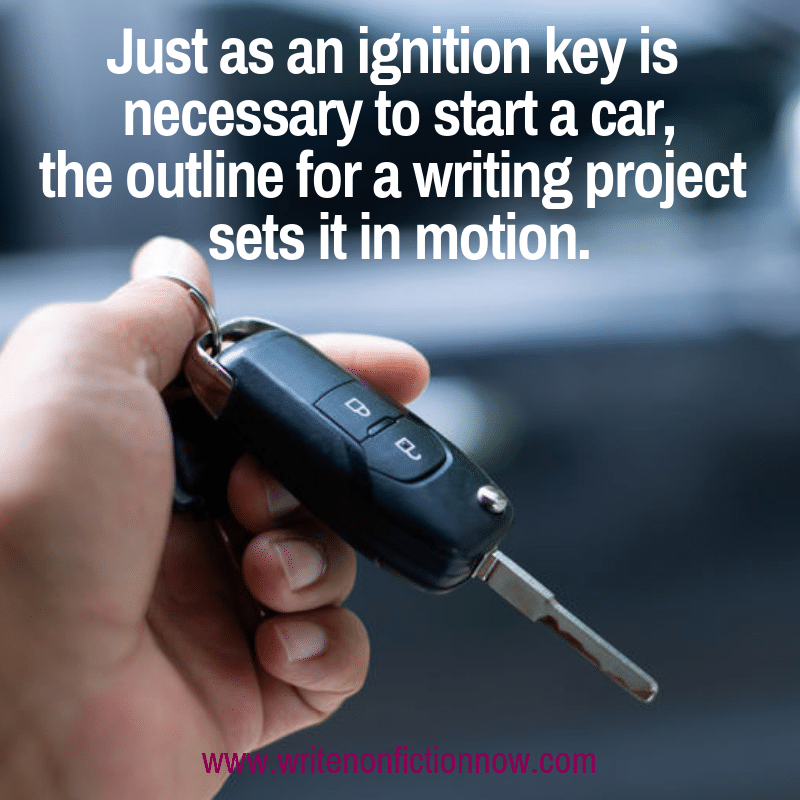A lot of people think that you need motivation to take action. However, taking action itself can motivate you to achieve. Once you get going, you realize you can do the work, and you are empowered to take the next step.
Think of it like driving a car: it’s only once you take the action to turn the key that the engine starts, which enables the pedals to work and the wheels to turn. Ultimately, these actions lead to other actions, and they enable you to easily drive off to wherever you need to go. And once you’re in a car, with the engine running, you’re not likely to decide not to go somewhere. Everything’s already in motion.
Writing is Like Driving a Car
The car example is an interesting one when you think of how it mirrors the writing process. After all, a car starting is a complex mechanical process that you set into motion by taking one specific action—turning the key. It’s a scientifically proven, predictable chain reaction. At the same time, while this is a mechanical process, it’s also something much more familiar. It’s a routine.
Writing, too, is a routine. There’s a predictable process: planning, writing, revising, publication. Like driving, once you take action and start a writing routine, taking each action is easier, and eventually, you are in motion.
Your First Action: Outlining
The outline is the first part of this routine. It’s the initial action you need to take to get to your next action in the chain. Most of us learn to outline in high school as a part of learning to write the dreaded five-paragraph essay.
Here’s the basic formula, which can carry over to pretty much any type of writing:
I. Introduction
II. Body paragraph one
a. Topic one
b. Topic two
c. Topic three
III. Body paragraph two
a. Topic one
b. Topic two
c. Topic three
IV. Body paragraph three
V. Conclusion
An Essential Step in Writing Nonfiction
Outlines are essential for nonfiction writing because the integrity of the piece hangs upon the logical progression of the ideas presented. Even in autobiography or more creative nonfiction, you want the story to make sense and be easy to follow. An outline helps you stay on track to hit all the essential parts of the narrative, and it shows you where you might have gaps.
Plus, seeing your argument laid out in such a stripped-down way, without the trappings of beloved turns of phrase surrounding it, will force you to scrutinize whether or not the narrative you’re planning makes sense. It also gives you the opportunity to change it before you get too far down the rabbit hole.
Some writers are resistant to outlining because they think it will stifle their creativity. In my view, though, outlining can be a form of organized brainstorming. It’s a very creative process in that way as it prompts you to chase down the bits of your ideas that you haven’t yet uncovered and put into place. And the outlining process might even spur you into writing more than you were expecting. An article might become a book! A book may become a trilogy!
The Difference Between Outlining and Writing
The trick to making the outline truly useful in the writing process is to know the difference between planning an argument and doing the actual writing. You don’t want to leave too much unplanned, which will put you in the position of losing the thread of the argument. But you also don’t want the piece to read like a list of bullet points of information.
I tend to fill in more and more detailed points of my argument into my nonfiction outlines until I am starting to think of the more writerly parts of the piece, like the transition sentences I want to use between paragraphs or the stories I want to use to open or close out the narrative. I might jot these ideas down if they come to me while I’m still outlining; that’s the signal to me that I’ve successfully outlined my argument and I now need to start the process of putting pen to paper. Again, this just goes to show how creative the outlining process can be.
A Living Document
Of course, once the writing itself begins, you shouldn’t set your outline aside. My advice to writers is to keep your outline as a living document. You might find that, while writing, you realize a sudden glaring omission and that you need to adjust future paragraphs for the piece to really work. Or, as you’re revising a first draft, you might need to go back and re-outline a part of the piece that isn’t making enough sense so you can do a better job rewriting it.
Like the key in the car’s ignition, the outline is an essential tool that propels you into action the way the key helps bring the car to life. And with each action, another action follows, and pretty soon you’ve started—and are on your way—to a new piece of writing.
Do you start your writing projects with an outline? Tell me in a comment below.
About the Author
 C.K. Bush is a nonfiction editor and writer. She lives in New York City.
C.K. Bush is a nonfiction editor and writer. She lives in New York City.
Photo copyright: Somsak Khamkula/123rf.com
